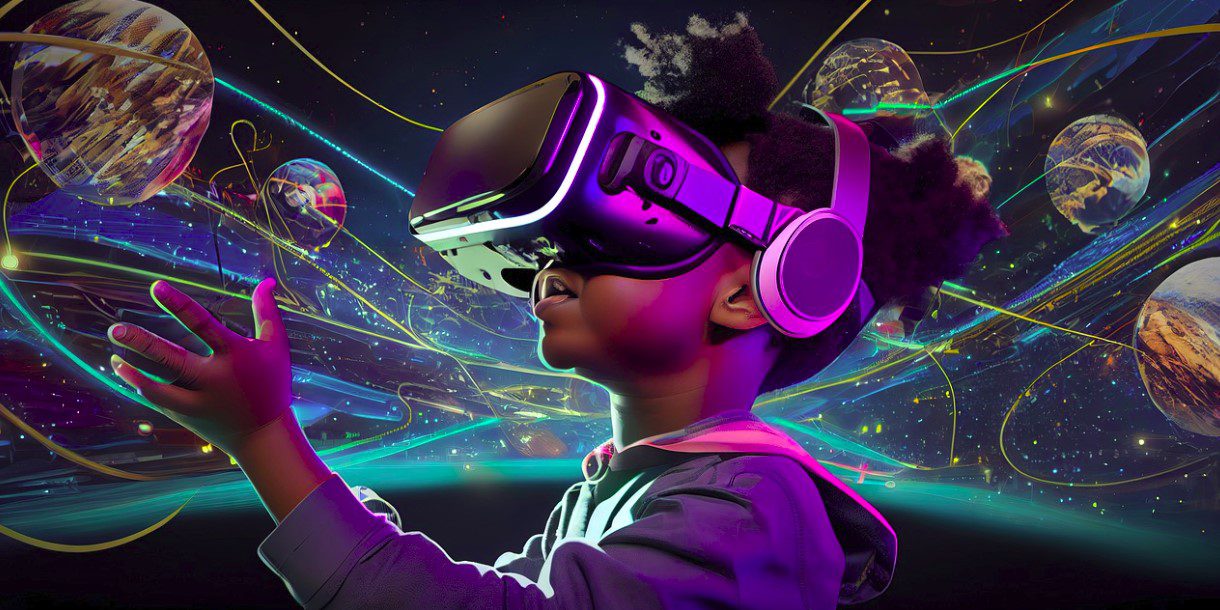The Metaverse refers to a virtual world where users interact with each other in a shared digital space. It is a three-dimensional virtual space where users can create avatars and interact with each other in real-time.
In these virtual spaces, users can attend virtual events, visit virtual shops, play games, and even attend virtual classes or meetings. It is meant to be a fully immersive experience where users can explore and interact with digital environments as if they were real.
Users can also teleport from one location to another as holograms. (See image below)

The Metaverse is a concept popularized by science fiction movies such as Ready Player One, Avatar, and Free Guy. It is accessible through virtual reality (VR) and augmented reality (AR) devices, such as headsets or smartphones.
How the Metaverse Works in Real Life
The Metaverse is not yet commonplace, as it is still in the development phase. Still, many companies are investing heavily in its development. Currently, video games offer the most immersive metaverse-like experiences available. Game developers have pushed the limits of conventional gaming by organizing in-game events and establishing virtual economies. Tech giants like Facebook and Google are also pushing the idea to the next level.
Here are a few examples of how it is being used today:
1. In the Workplace:
The metaverse has the potential to revolutionize the way we work and collaborate in the workplace. Here are some ways it could be used:
- Virtual meetings: Instead of physical meetings, teams can gather in a virtual space in the metaverse, eliminating the need for travel and reducing carbon footprint. The virtual space could also offer more flexibility in terms of scheduling and location.
- Remote collaboration: With the metaverse, teams can work together on projects from different parts of the world in real-time. They can collaborate on virtual whiteboards, share files, and communicate through avatars.
- Training and development: The metaverse can be used to train employees through immersive simulations, allowing them to learn by doing. This can be particularly useful for industries like healthcare and manufacturing where hands-on training is essential.
- Virtual workspaces: Companies can create virtual workspaces in the metaverse, where employees can access tools, resources, and information in a centralized location. This can improve efficiency and productivity by reducing the need for employees to switch between multiple apps and platforms.
- Customer engagement: Companies can use the metaverse to create immersive experiences for their customers, such as virtual showrooms, product demos, and interactive games. This can improve customer engagement and provide a competitive advantage.
2. Education:
The Metaverse has the potential to transform the way we learn and teach. Here are some ways it could be used:

- Immersive learning experiences: The metaverse can offer immersive experiences that allow students to explore and interact with virtual environments, making learning more engaging and memorable. For example, students can explore historical sites, participate in virtual simulations, and practice real-life scenarios.
- Remote learning: The metaverse can enable remote learning by providing a virtual classroom where students and teachers can interact from anywhere in the world. This can improve access to education and reduce the cost of travel and infrastructure.
- Personalized learning: The metaverse can offer personalized learning experiences by adapting to each student’s individual needs and learning style. For example, students can learn at their own pace, receive instant feedback, and access customized learning resources.
- Collaboration and social learning: The metaverse can facilitate collaboration and social learning by allowing students to work together in virtual teams, share ideas, and learn from each other. This can foster a sense of community and improve teamwork skills.
- Skill development: The metaverse can provide opportunities for students to develop new skills, such as coding, design, and entrepreneurship. They can participate in virtual workshops, mentorship programs, and networking events.
AS a whole, the Metaverse will revolutionize education, by hyping up the 21st century classroom to virtual spaces. As such, teachers of the 21st century will have to reinvent education to suit the new learning experiences.
3. The Health Sector:
The metaverse has the potential to transform the health sector in many ways. Here are some examples:
- Medical training: The metaverse can provide a safe and realistic environment for medical training, allowing healthcare professionals to practice procedures and simulations without risking patient safety. This can be particularly useful for rare or complex procedures, as well as for training healthcare professionals in different parts of the world.
- Virtual healthcare: The metaverse can facilitate virtual healthcare by providing remote consultations, monitoring, and support for patients. This can improve access to healthcare, reduce the cost of infrastructure, and allow patients to receive care from the comfort of their homes.
- Patient education: The metaverse can offer immersive and interactive patient education, allowing patients to learn about their conditions, treatments, and self-care in a more engaging and accessible way. This can improve patient understanding, compliance, and outcomes.
- Mental health support: The metaverse can provide virtual support and therapy for mental health conditions, such as anxiety and depression. Patients can interact with virtual avatars, participate in virtual support groups, and receive cognitive-behavioral therapy.
- Health promotion: The metaverse can offer virtual health promotion and wellness programs, such as virtual fitness classes, healthy cooking workshops, and stress management sessions. This can promote healthy behaviors and prevent chronic diseases.
4. Gaming:
Many online games already offer virtual worlds where players can interact with each other and explore digital environments. Games like Second Life and Minecraft are early examples of this.
5. Virtual Events:
Due to the COVID-19 pandemic, virtual events have become more common. The Metaverse offers an opportunity to host fully immersive virtual events, such as conferences, concerts, and exhibitions.
6. Virtual Real Estate:
Some companies are already selling virtual real estate within the Metaverse. Users can purchase digital land and build virtual properties, which can potentially increase in value over time.
7. Socializing:
The Metaverse offers a new way for people to socialize and connect with each other. Users can create avatars and interact with each other in virtual environments. This can be used for dating, networking, or simply making new friends.
It is expected that as the technology behind the Metaverse advances, more and more applications will be developed for it. It could potentially revolutionize the way we work, socialize, and interact with technology.
The Good About Virtual Spaces
The Metaverse has the potential to offer several advantages, including:
1. Immersive experiences:
The Metaverse is designed to be a fully immersive experience, where users can explore and interact with digital environments as if they were real. This could provide new ways to learn, work, and play.
2. Accessible from anywhere:
The Metaverse is accessible from anywhere, as long as you have a compatible device and an internet connection. This could potentially allow people to participate in virtual events, work, and socialize with others from all over the world.
3. New opportunities for business:
The Metaverse could potentially create a new economy, with its own virtual currencies and goods that can be bought and sold. This could provide new opportunities for entrepreneurs and businesses to make money within the virtual world.
4. Enhanced socialization:
The Metaverse offers new ways for people to socialize and connect with each other. Users can create avatars and interact with each other in virtual environments, which could potentially help people feel more connected and less isolated.
5. Improved accessibility:
The Metaverse could potentially provide a more accessible environment for people with disabilities. For example, virtual environments can be designed to be more accommodating to people with mobility or sensory impairments.
6. Increased creativity:
The Metaverse could provide a platform for users to express themselves and create new things. Users can create their own digital content, such as virtual clothing, furniture, and buildings, which could potentially inspire new forms of creativity and innovation.
Overall, the Metaverse has the potential to offer a range of benefits and advantages, from immersive experiences to new opportunities for business and socialization. As the technology behind the Metaverse continues to develop, it is likely that even more advantageswill emerge.
The Bad About Virtual Spaces
While the Metaverse has the potential to offer many advantages, there are also some potential disadvantages to consider, including:
1. Addiction:
Virtual spaces can potentially be addictive, just like any other form of technology. Users may become too immersed in the virtual world, leading to neglect of real-life responsibilities and relationships.
2. Social Isolation:
While the Metaverse offers new ways to socialize, it could also lead to increased isolation. Users may become too reliant on virtual interactions and neglect real-life socialization.
3. Security Risks:
A virtual space of any kind can be vulnerable to security risks, such as hacking, identity theft, and other cyber attacks. This could potentially compromise the safety and privacy of users.
4. Digital Divide:
The Metaverse requires access to compatible devices and internet connectivity, which could create a digital divide between those who have access to the technology and those who do not.
5. Escapism:
The Metaverse could be seen as a form of escapism, allowing users to avoid real-life problems and challenges rather than confronting them directly.
6. Dependency on Technology:
The Metaverse could potentially lead to an increased dependency on technology, with users relying more heavily on virtual experiences than real-life experiences.
Overall, while the Metaverse offers many potential benefits, it is important to consider and address these potential disadvantages as well. By doing so, it may be possible to create a more balanced and positive virtual environment for users.
The Final Word
The Metaverse presents a new frontier in technology and human interaction. Its potential to revolutionize the way we learn, work, socialize, and do business is immense. From immersive experiences to new economic opportunities and enhanced socialization, its advantages are many.
However, it is important to acknowledge and address the potential downsides of this technology. Addiction, isolation, security risks, digital divide, escapism, and dependence on technology are all concerns that need to be taken seriously.
As we move forward, it is crucial that we prioritize the safety and well-being of users. By doing so, we can create a virtual environment that fosters creativity, innovation, and connection, while minimizing the risks and drawbacks.





Leave a Reply